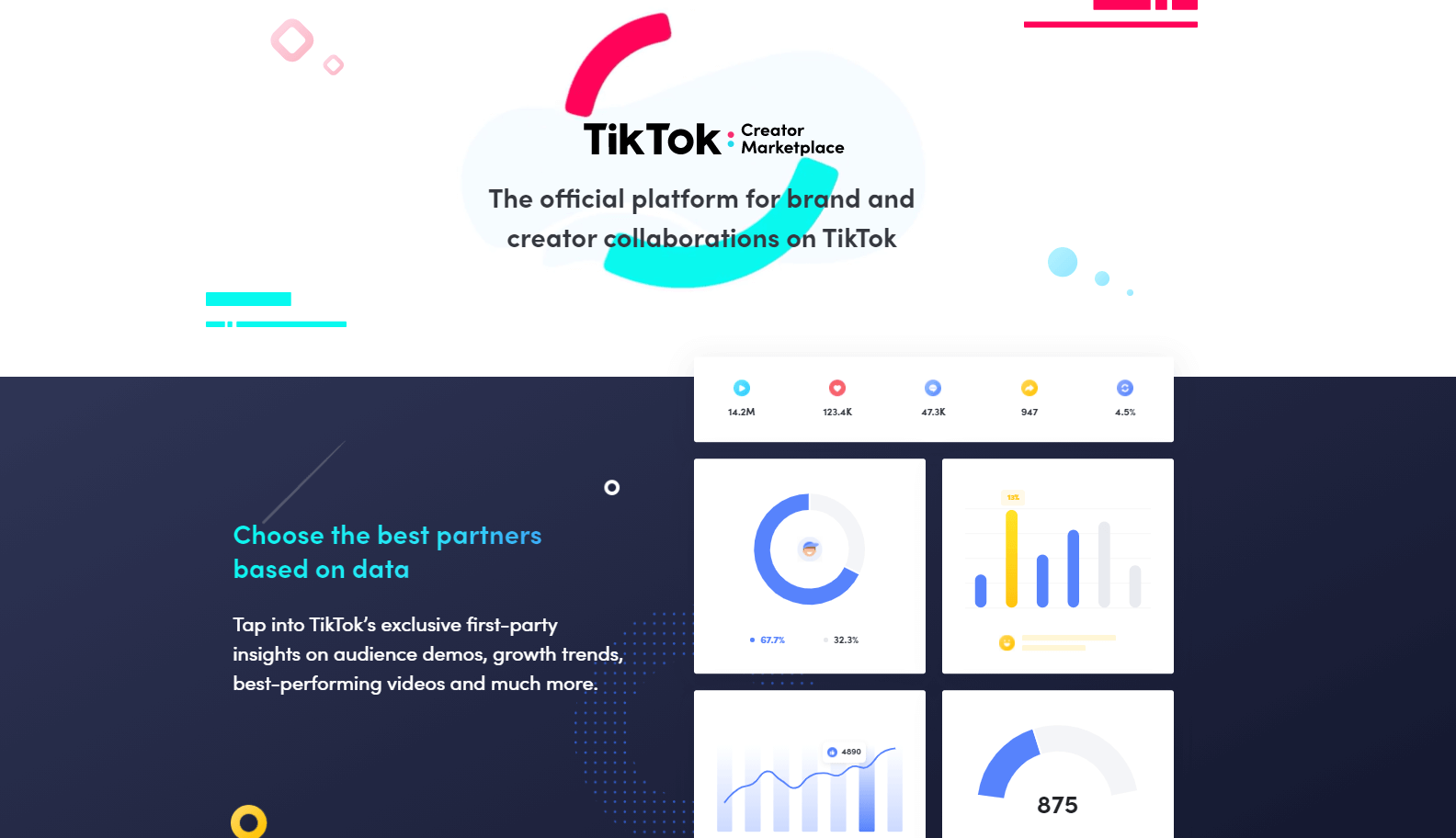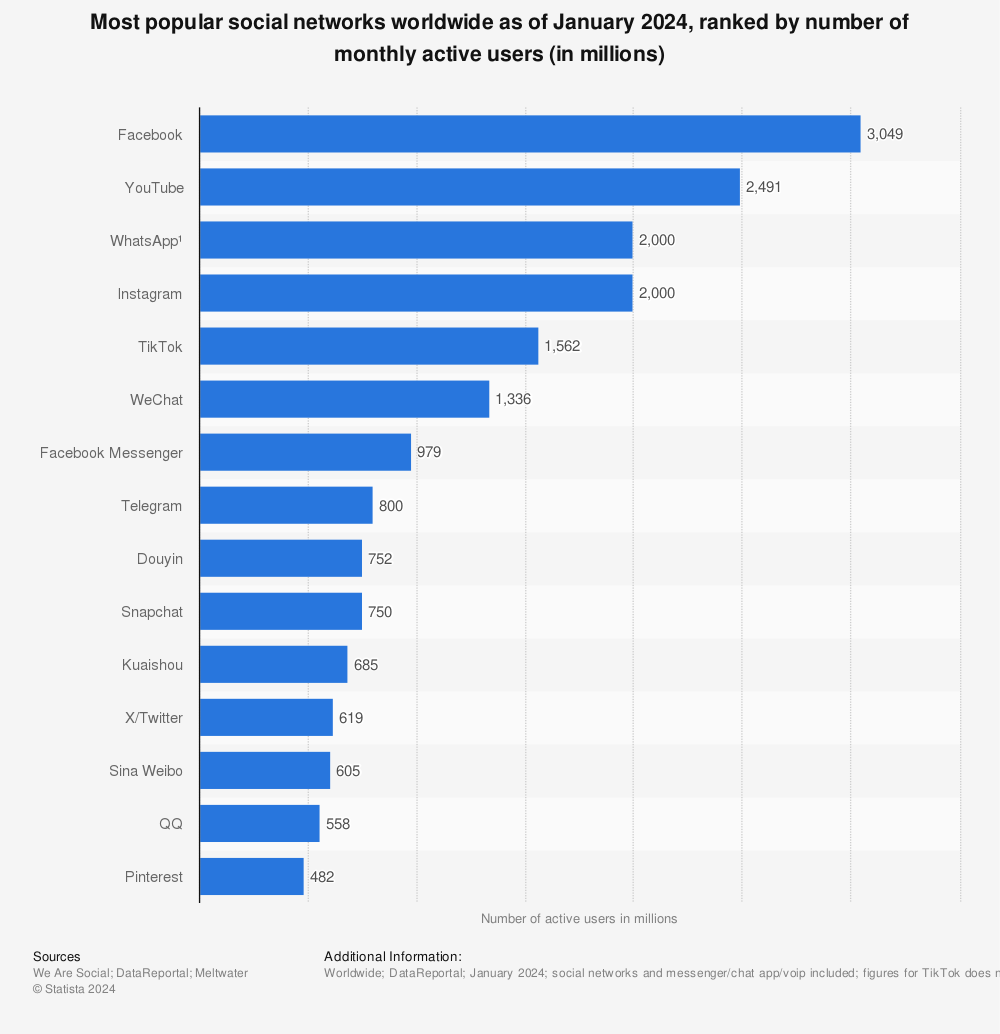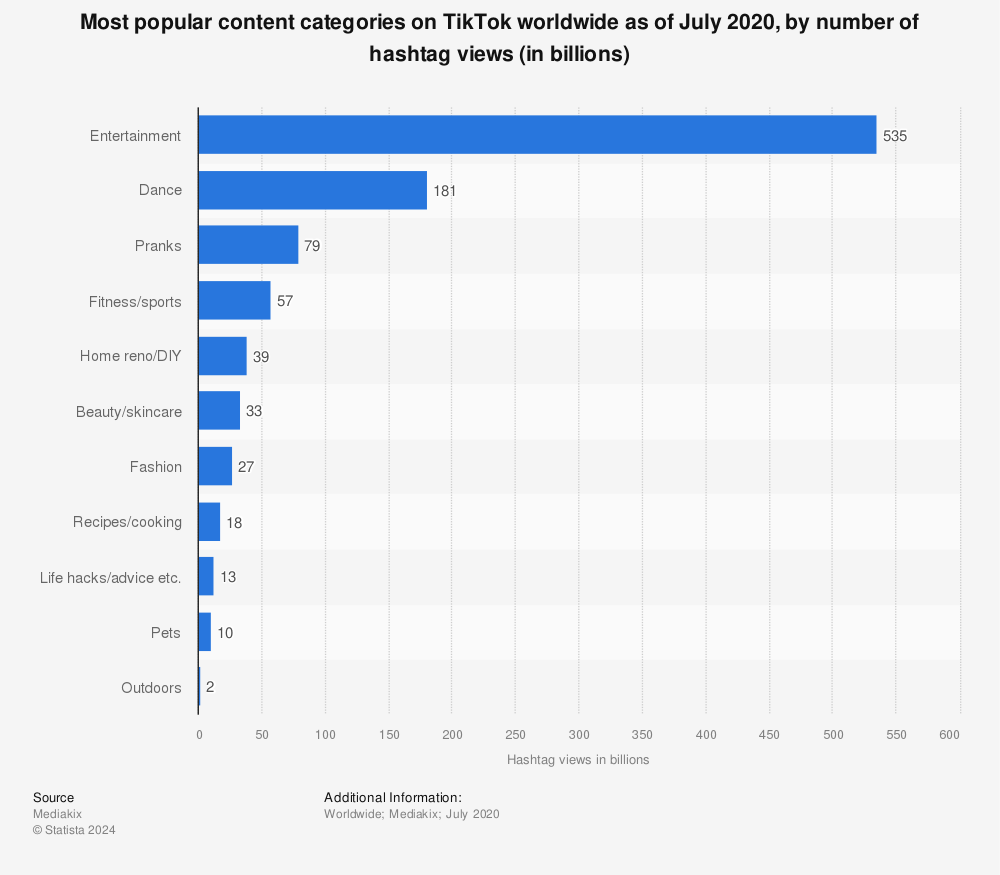People have been flocking to TikTok since the early days of its launch. If you’re a marketer, this means a lot of potentially valuable data to take advantage of. However, the sheer volume can make it hard to know which TikTok statistics are worth paying attention to.
Fortunately, you don’t need to sift through piles of information. There are a few key TikTok statistics in 2021 to help you narrow your search and optimize your marketing.
In this article, we’ll walk you through eight of the most important TikTok statistics for this year. We’ll also explain why they matter and how you can use them as part of your marketing strategy. Let’s dive right in!
As of July 2021, TikTok is more popular than Snapchat, Pinterest, and Twitter
You probably don’t need us to tell you that TikTok is popular. While it’s yet to reach the active user count of giants like Facebook or Instagram, the short-form video app has started to edge out other popular competitors[1]:
Find more statistics at Statista
You might want to use this information to adjust your strategy. For example, Snapchat’s easy advertising features arguably make it the fastest way to launch a campaign. However, speed isn’t everything.
As TikTok pulls ahead in terms of users, it may be worth familiarizing yourself with its marketing system. The same goes for Twitter, with its 397 million active users that are virtually dwarfed by TikTok’s 732 million.
Nevertheless, you may not want to rely on popularity alone. This is because the total number of users may not reflect those receptive to your marketing. Even if TikTok is more popular than Pinterest, this doesn’t necessarily mean you’ll find more success there.
As such, we advise you to take this statistic under careful consideration. It may influence your strategy, but it probably shouldn’t be the only factor in your plan.
Up to 55 percent of people between 18 and 24 years old report using TikTok
This data confirms something you probably already suspected: many young users are on TikTok. More than that, the statistic shows that over half of this age range[2] admits to using the platform. However, this figure is less about the number of users and more about the cultural conversation among young people.
These respondents aren’t just aware of TikTok – most of them are active users. The platform has virtually become a staple for this age bracket. When combined with TikTok’s robust out-of-app sharing options, its access to young audiences is unparalleled.
There are a few reasons to focus on reaching this demographic. For example, these users are just starting to purchase most of their own products and may be open to new options. As such, making brand connections now could create life-long loyal customers.
Moreover, there are multiple milestones for this age bracket that could help guide your marketing. Most of TikTok’s audience is likely moving away from home, starting college, or entering the workforce. Framing your advertising with these events can thus help you quickly connect through common ground.
Finally, TikTok’s popularity among the 18-24 age bracket may also have implications for future technology. Newer apps might also experience a similar boom as the next generation discovers social media. Therefore, we’d recommend investigating some TikTok alternatives to be prepared.
53 percent of TikTok users in the U.S. are 30 years of age or older
We’ve already discussed some TikTok statistics that focus on age. However, despite the app’s young reputation, not all of its users are teenagers. In fact, this breakdown shows that more than half of them are over 30 years old[3]:
| Age group | Share of users |
|---|---|
| 10-19 | 25% |
| 20-29 | 22.4% |
| 30-39 | 21.7% |
| 40-49 | 20.3% |
| 50+ | 11% |
This data shows that while there’s definitely a large market for younger users, they’re not the only ones you can reach with TikTok. In particular, people between 30 and 39 represent an impressive 21.7 percent of TikTok members.
As such, we don’t recommend ignoring TikTok even if your target demographics skew older: there are still approximately 387 million active users older than 29. However, you may want to think carefully about how you’ll format your content for this age bracket.
For instance, humor can be an effective way to connect with your audience. Even so, age can impact an audience’s reaction.
For example, a 16-year-old might not be able to relate to a joke about floppy disks as well as a 35-year-old. That’s why we highly recommend that you analyze how relevant your content will be to the age bracket you’re trying to reach.
If you’re not confident in your ability to manage content for older viewers, we suggest considering a social media manager. The right professional can help you adapt to a valuable market while still maintaining a consistent brand identity.
As of February 2021, TikTok is the top-grossing non-gaming app worldwide
In terms of both overall revenue and App Store revenue, TikTok is the undisputed leader. In February 2021, the app generated more than $110 million worth of user spending – 1.9 times its revenue in February 2020.[4]
All of this spending suggests a lot of potential beyond marketing. In addition to running ads, you may also want to sell products. This TikTok statistic suggests that its user base is receptive to direct purchases through the app.
However, this data isn’t just about the impressive earnings and growth. Let’s also take a look at which apps TikTok surpassed. Most notably, it outperformed two typically long-form competitors: YouTube and Twitch.
These rankings suggest that short-form content might be a better way to generate user revenue in 2021. We’re not saying that long-form content isn’t worth your time, but it could be more effective for other marketing goals, such as establishing your brand’s voice.
Nevertheless, even short-form custom content can be time-consuming to create. If you’re looking for a tool that can help you with the work, consider our Revive Old Posts plugin. It can help you optimize your content’s performance by keeping it on a consistent rotation.
TikTok is used evenly across income ranges from under $30 thousand to over $75 thousand
A viewer’s income is usually an important part of their customer profile. It can influence what products they need or can afford. As such, this data might be worth integrating into your advertising plans.
TikTok statistics show that this platform offers you a lot of income audience options: data shows that the $30-$75 thousand income brackets[5] all use the app with relative equality, varying by only a few percentage points.
This distribution may seem like an obstacle if you were hoping to focus on one income demographic. However, TikTok actually offers a platform-specific tool to solve this issue: the TikTok Creator Marketplace. This collaboration resource can help you find a partner to organically reach your desired financial group:


We recommend that you use this platform to choose your influencers carefully. The closer your partnership can get you to your target income bracket, the more likely it is that you’ll be able to maximize your social media Return On Investment (ROI).
However, we also encourage you to consider other demographic data such as age and gender alongside income levels. Doing this can expand your potential audience, thus improving your overall odds of securing conversions.
37 percent of TikTok users earn a total household income over $100 thousand per year
Shifting back to the total number of users, recent data suggests that up to 37 percent of them belong to relatively wealthy households.[6] This income bracket surpasses the next largest group – those who earn under $25 thousand per year – by an impressive 19 percent.
This is one of the top TikTok statistics to consider if you’re on the fence about the platform. As we’ve mentioned before, a user’s income can greatly impact their interest in your product. However, this rule doesn’t just apply to the budget constraints of lower-income households.
For example, let’s say you’re marketing a simple app at an affordable price. Wealthier TikTok users might be more likely to choose an app with more features at a higher cost. As such, your TikTok ads might be instantly irrelevant to up to 37 percent of viewers.
On the other hand, this information also suggests that TikTok could be a valuable opportunity if you sell ‘freemium’ products. These are products that usually offer a limited free version. Users can then upgrade to a paid plan later on.
These accessible products can be effective because they straddle multiple financial levels. This can decrease the need to target specific household incomes, making it a perfect way to reach the maximum number of TikTok users.
Micro-influencers experience an engagement rate of nearly 18 percent
Influencer culture is commonly associated with Instagram. However, that doesn’t mean it’s necessarily the best platform to invest in for that strategy. In fact, recent TikTok statistics show the app to be a rising star in this field.
For every level of influencer engagement, TikTok outperforms both YouTube and Instagram. Micro-influencers – those who have a following of 15,000 or fewer – are particularly successful on TikTok.
These creators receive an astounding 17.96 percent engagement rate benchmark.[7] By comparison, Instagram influencers with a similar follower count only garner 3.86 percent. This surprising statistic might be reason enough for you to rethink your affiliate marketing strategy.
TikTok affiliates clearly show a lot of promise. However, while engagement rates might encourage more purchases, they’re not a direct line to profits. Therefore, we highly encourage you to have patience with your influencer partnerships.
Fortunately, affiliate programs can be a very affordable way to market your brand and products. The commission structure means you’ll only need to invest in an influencer after they’ve proven they can drive sales. However, you may want to consider increasing these payments for profitable creators to encourage their success further.
Entertainment is the most popular content category on TikTok
TikTok is home to a wide variety of content types. Videos are sorted into categories to deliver relevant content to users.
Among these categories, the general-sounding Entertainment option is the most popular, with 535 billion hashtag views.[8] It’s not a close race, either. The next most popular category is Dance with 181 billion hashtag views, followed by Pranks with 79 billion:
Find more statistics at Statista
However, this doesn’t mean that all of your content should be labeled as Entertainment. For example, you might be partnering with a fitness influencer. Even though their main category draws a comparatively lower number of views, this might not matter if they can effectively reach your target audience.
Nevertheless, you may still want to consider partnering with a few Entertainment creators if you haven’t already. As long as they have quality content that’s still relevant to your brand, it might be worth branching out for the large potential audience.
Despite the possible increase in views, we highly recommend that you avoid miscategorizing content. It is unlikely to reach interested customers, and it might actually hurt you in the long run if it annoys viewers or miscommunicates your product.
Conclusion on TikTok statistics
TikTok is still a relatively new app. New information comes in every day, which can make keeping up a struggle. Fortunately, you can stay on top of your marketing strategy by focusing on the most relevant data.
In this article, we covered eight helpful TikTok statistics:
- TikTok is more popular than Snapchat, Pinterest, and Twitter.
- More than half of people aged 18-24 use TikTok.
- More than half of the American TikTok users are aged 30 or over.
- TikTok is the top-grossing non-gaming app worldwide.
- The platform is used evenly across the $30,000-75,000 income ranges.
- 37 percent of TikTok users earn more than $100 thousand per year.
- TikTok micro-influencers have an engagement rate of nearly 18 percent.
- Entertainment is the most popular category on TikTok.
Do you have any questions about using these TikTok statistics to further your marketing strategy? Let us know in the comments section below!
[1] https://www.statista.com/statistics/272014/global-social-networks-ranked-by-number-of-users
[2] https://www.pewresearch.org/internet/2021/04/07/social-media-use-in-2021
[3] https://www.statista.com/statistics/1095186/tiktok-us-users-age
[4] https://sensortower.com/blog/top-grossing-apps-worldwide-february-2021
[5] https://www.pewresearch.org/internet/2021/04/07/social-media-use-in-2021
[6] https://www.marketingcharts.com/digital/social-media-108342
[7] https://influencermarketinghub.com/influencer-marketing-benchmark-report-2021
[8] https://www.statista.com/statistics/1130988/most-popular-categories-tiktok-worldwide-hashtag-views
The post 8 Essential TikTok Statistics That Marketers Need to Know appeared first on Revive Social.



